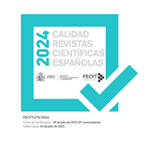Engaging in predatory practices: How editors persuade prospective authors
Resumen
A number of studies have explored the main features of predatory practices that prevail in predatory academic journals and conferences. However, not much has been investigated regarding the ways predatory journal editors convey credibility and trustworthiness when addressing scholars looking for publication outlets and, more specifically, what interpersonal resources (like proximity or engagement markers) are used to persuade them. This exploratory study draws on a dataset of fifty email messages from predatory publishers collected during the past two years. It seeks to delve into the ways predatory journal editors address “scholar customers” with the aim of persuading them to submit their work. This dataset was first coded following Hyland’s models of proximity and interaction in academic texts, and then qualitatively analysed using NVivo 11 Pro. The analysis shows that (i) textual data provide direct evidence of the texts that predatory publishers send to scholars and the interpersonal dialogue they intend to build with authors in haste for publication; (ii) interactional resources abound, particularly engagement markers, which explicitly aim at building a rapport with the prospective author; and (iii) these predatory texts also contain other engagement-related elements directed to have an effect on the reader’s decision for eventual submission.
Descargas
Descarga artículo
Licencia
La revista Círculo de Lingüística Aplicada a la Comunicación, para fomentar el intercambio global del conocimiento, facilita el acceso sin restricciones a sus contenidos desde el momento de su publicación en la presente edición electrónica, y por eso es una revista de acceso abierto. Los originales publicados en esta revista son propiedad de la Universidad Complutense de Madrid y es obligatorio citar su procedencia en cualquier reproducción total o parcial. Todos los contenidos se distribuyen bajo una licencia de uso y distribución Creative Commons Reconocimiento 4.0 (CC BY 4.0). Esta circunstancia ha de hacerse constar expresamente de esta forma cuando sea necesario. Puede consultar la versión informativa y el texto legal de la licencia.











